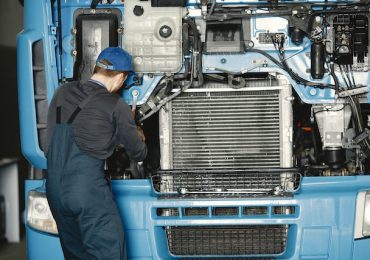In the bustling transportation industry, the reliability and efficiency of trucks play a crucial role in keeping goods moving across the world. Truck parts maintenance is a vital aspect of ensuring the smooth operation of these vehicles. However, traditional maintenance strategies often fall short of addressing the evolving needs of modern fleets. This is where technology steps in, revolutionizing the way truck parts are maintained. In this blog, we will explore how technology is transforming truck parts maintenance strategies, improving efficiency, reducing downtime, and saving costs.
Traditional Truck Parts Maintenance Strategies
Traditional truck parts maintenance strategies have long relied on manual inspections and scheduled maintenance routines. These strategies involve periodic checks and replacements of components based on predetermined time intervals or mileage thresholds. While these approaches are necessary to ensure the safety and reliability of trucks, they have several limitations.
Manual inspections are time-consuming and often reactive, as they rely on visual observations of components without real-time data. This means that issues may go undetected until they become noticeable or cause breakdowns. Moreover, scheduled maintenance routines can lead to unnecessary repairs or part replacements, increasing costs and causing downtime without any real benefit. Instead of addressing specific needs, these strategies follow a one-size-fits-all approach, resulting in inefficiencies and potential missed opportunities for optimization.
Role of Technology in Truck Parts Maintenance
The role of technology in truck parts maintenance is significant and has revolutionized the way heavy-duty vehicles are repaired and maintained. According to the team from Shoreline Truck Parts, technology has emerged as a vital ally in the rapidly changing world of truck maintenance. Technological innovations are now integrated into truck HVAC boxes, brake line assemblies, and other integral parts. Another one of the notable advancements is computer diagnostics, which acts as a digital tool that helps identify and diagnose issues with precision. These diagnostic tools are like doctors for trucks, allowing technicians to quickly and accurately assess problems and determine the necessary repairs.
Furthermore, online service information and advanced technology have increased technician efficiency and productivity in truck maintenance. By leveraging the power of technology, technicians can access comprehensive service manuals, repair guides, and real-time troubleshooting instructions. This enables them to work more efficiently, speeding up diagnostics and repairs. Additionally, the use of technology in truck parts maintenance allows for proactive maintenance practices. Sensors and IoT devices installed in critical components continuously monitor their performance, providing valuable data on the health and usage patterns of these parts. This data, combined with predictive analytics and machine learning algorithms, helps fleet managers and technicians identify potential failures before they happen, allowing for proactive repairs and replacements.
Key Technological Innovations in Truck Parts Maintenance
Several innovative technologies have paved the way for more efficient and effective truck parts maintenance. Sensor technology plays a pivotal role in condition monitoring, detecting early signs of wear or potential failures. By continuously monitoring critical components such as engines, brakes, and tires, fleet managers can identify issues before they escalate, allowing for timely repairs or replacements.
Predictive maintenance software and algorithms analyze the data collected from sensors, historical maintenance records, and other relevant data sources. By leveraging machine learning, these systems can predict when a part is likely to fail and recommend maintenance actions accordingly. This proactive approach helps prevent unexpected breakdowns and reduces downtime, leading to significant cost savings.
Augmented reality (AR) is another technology transforming truck parts maintenance. Using AR-enabled devices or smart glasses, technicians can access real-time troubleshooting instructions, repair manuals, and virtual overlays to identify and fix issues quickly. This technology empowers technicians with on-the-spot guidance, reducing the time required for repairs and improving overall efficiency.
Benefits of Technology-driven Maintenance Strategies
The adoption of technology-driven maintenance strategies brings forth a multitude of benefits for fleet managers and truck operators alike. Firstly, these strategies increase uptime by minimizing unplanned breakdowns and reducing downtime for repairs. By adopting a proactive approach, fleet managers can schedule maintenance during planned downtime, ensuring that trucks are back on the road as quickly as possible.
Secondly, technology-driven maintenance strategies result in significant cost savings. By analyzing real-time data and adopting predictive maintenance practices, fleet managers can optimize maintenance schedules, avoiding unnecessary repairs and replacements. This not only reduces labor and material costs but also extends the lifespan of truck parts, resulting in long-term savings.
Thirdly, incorporating technology into truck parts maintenance enhances safety and compliance with regulations. Real-time monitoring allows fleet managers to detect safety issues promptly and take necessary corrective actions. Additionally, by maintaining vehicles in optimal condition, operators can meet regulatory standards and ensure the safety of their drivers and cargo.
Future Trends in Truck Parts Maintenance
Future trends in truck parts maintenance are shaping the industry, driven by advancements in technology and changing demands. According to sources such as FleetOwner and DieselMatic, here are some key future trends to watch:
Increased Use of Technology
Technology will continue to play a crucial role in truck parts maintenance. The use of IoT devices and sensors will enable real-time monitoring of components, providing valuable data on their performance and health. This data-driven approach allows for proactive maintenance, minimizing downtime and reducing costs.
Predictive Maintenance
The adoption of predictive maintenance strategies is expected to rise. By analyzing vast amounts of data using advanced algorithms, fleet managers can predict potential failures and schedule maintenance before breakdowns occur. This proactive approach helps optimize repairs, minimize unplanned downtime, and maximize the lifespan of truck parts.
Remote Monitoring and Diagnostics
Remote monitoring and diagnostics will become more prevalent. Technicians will be able to remotely access and analyze data from trucks, allowing them to diagnose issues without physically being present. This trend enables faster troubleshooting and reduces the need for unnecessary on-site visits.
Embracing Automation
Automation will play a significant role in streamlining truck parts maintenance processes. Robotic systems and automated tools will assist technicians in tasks such as inspections, repairs, and part replacements. This improves efficiency, reduces human error, and increases productivity.

These future trends in truck parts maintenance indicate an industry shift towards proactive and data-driven approaches, ultimately leading to improved efficiency, reduced costs, and enhanced reliability in truck operations.
Technology is revolutionizing truck parts maintenance strategies, enabling proactive and data-driven approaches that improve efficiency, reduce downtime, and save costs. From real-time monitoring and predictive analytics to augmented reality and future advancements in AI and blockchain, the possibilities for enhancing truck parts maintenance are endless. By embracing these technological innovations, fleet managers and truck operators can optimize their maintenance practices, ensure the reliability of their vehicles, and keep goods moving smoothly across the world.
